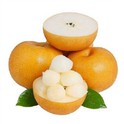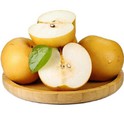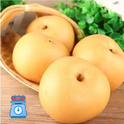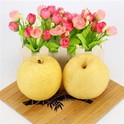As a supplier of the Lovely Pear, I've always been fascinated by the story behind this remarkable fruit. The origin of the Lovely Pear is a tale that combines nature's artistry with human intervention, resulting in a pear that stands out in the market for its exceptional taste and appearance.
Ancient Beginnings and Natural Evolution
Pears, in general, have a long - standing history that dates back thousands of years. They are believed to have originated in the mountainous regions of Western China, where wild pear species still grow today. These wild pears were the starting point for the domestication and cultivation that would eventually lead to the creation of the Lovely Pear.
Wild pears were smaller and often had a more astringent taste compared to the pears we enjoy today. Over time, through natural selection and the influence of environmental factors such as climate, soil, and pests, different varieties of pears began to emerge. The Lovely Pear, like many other pear varieties, is a product of this long - term evolutionary process.
The natural crossing of different wild pear species in the wild led to the development of new genetic combinations. Some of these combinations resulted in pears with improved characteristics, such as better taste, larger size, and increased resistance to diseases. These favorable traits were then further refined through human cultivation.
Early Cultivation and Selective Breeding
As humans started to settle down and engage in agriculture, they began to select and cultivate the pears with the most desirable traits. Early farmers would plant the seeds of pears that they found particularly delicious or productive. However, growing pears from seeds is not a reliable way to reproduce the same characteristics, as the genetic makeup of the offspring can vary significantly.
This led to the development of grafting techniques. Grafting involves taking a cutting from a tree with the desired traits (the scion) and attaching it to the rootstock of another tree. This way, the new tree would inherit the exact genetic characteristics of the scion, ensuring that the pears produced would be consistent in quality.
The Lovely Pear, through a long process of selective breeding and grafting, was developed to have the perfect balance of sweetness, juiciness, and texture. Breeders would carefully cross different pear varieties, looking for combinations that would enhance the flavor, appearance, and shelf - life of the fruit. For example, they might cross a pear known for its sweet taste with another that was resistant to a particular disease, hoping to create a new variety that had both qualities.
Geographical Influence on the Lovely Pear
The geographical location where the Lovely Pear is grown also plays a crucial role in its development. Pears thrive in temperate climates with well - drained soil. The ideal conditions for growing the Lovely Pear include a cold winter period to allow the tree to go dormant and a warm, sunny growing season to develop the fruit.
In regions with the right climate, the Lovely Pear can reach its full potential. The soil composition, in particular, affects the flavor and texture of the fruit. For instance, soil rich in minerals such as calcium and potassium can contribute to a more robust flavor and a firmer texture. The amount of sunlight and rainfall during the growing season also impacts the sugar content and juiciness of the pears.
Some of the most renowned pear - growing regions around the world have unique micro - climates that are perfect for cultivating the Lovely Pear. These regions have a long history of pear cultivation, and the local farmers have developed traditional techniques that have been passed down through generations.


The Distinctive Features of the Lovely Pear
The Lovely Pear is known for its distinctive appearance. It has a smooth, golden - brown skin that is often speckled with tiny dots. The shape of the pear is classic, with a rounded bottom and a slightly tapered top. This shape not only makes it aesthetically pleasing but also contributes to its ease of handling.
When it comes to taste, the Lovely Pear is a true delight. It has a sweet, juicy flavor that is both refreshing and satisfying. The flesh of the pear is tender and buttery, with a fine texture that melts in your mouth. It is one of the Best Tasting Pear varieties available in the market, making it a favorite among consumers of all ages.
In addition to its great taste, the Lovely Pear is also a nutritious fruit. It is rich in dietary fiber, which is beneficial for digestive health. It also contains vitamins C and K, as well as antioxidants that help protect the body against free radicals.
The Role of the Wild Fragrant Pear Fruit
The Wild Fragrant Pear Fruit has played an important role in the development of the Lovely Pear. Wild pears often carry genes that are resistant to various pests and diseases. By cross - breeding the Lovely Pear with wild fragrant pear varieties, breeders have been able to introduce these resistance genes into the new variety.
This has made the Lovely Pear more resilient and less prone to damage from pests and diseases. As a result, farmers can grow the Lovely Pear with fewer pesticides, making it a more environmentally friendly and healthy choice for consumers. The wild fragrant pear also contributes to the unique aroma of the Lovely Pear, adding to its overall appeal.
The Lovely Pear in the Market
The Lovely Pear has gained popularity in the market due to its exceptional quality. It is one of the Best Pears For Eating right out of hand, but it can also be used in a variety of culinary applications. It is perfect for making pies, tarts, and jams, as its sweet flavor and firm texture hold up well during cooking.
As a supplier of the Lovely Pear, I have seen the growing demand for this fruit in both domestic and international markets. Consumers are increasingly looking for high - quality, delicious, and nutritious fruits, and the Lovely Pear fits the bill perfectly.
Connecting with Potential Buyers
If you are interested in sourcing the Lovely Pear for your business, whether it's a grocery store, a restaurant, or a food distributor, I would be more than happy to discuss your needs. The Lovely Pear is a product that I am passionate about, and I believe it has a lot to offer to your customers.
We ensure that our pears are grown using sustainable farming practices, which not only protect the environment but also result in a higher - quality product. Our team is dedicated to providing the best customer service, from the moment you express interest to the delivery of the fruit.
Whether you are looking for a small quantity for a special event or a large - scale supply for your business, we can work with you to meet your requirements. Please feel free to reach out, and let's start a conversation about how the Lovely Pear can enhance your product offerings.
References
- "The History of Pears" - Agricultural History Journal
- "Pear Breeding and Cultivation" - Horticultural Science Review
- "Wild Pear Species and Their Contribution to Cultivated Varieties" - Genetic Resources in Fruit Crops






